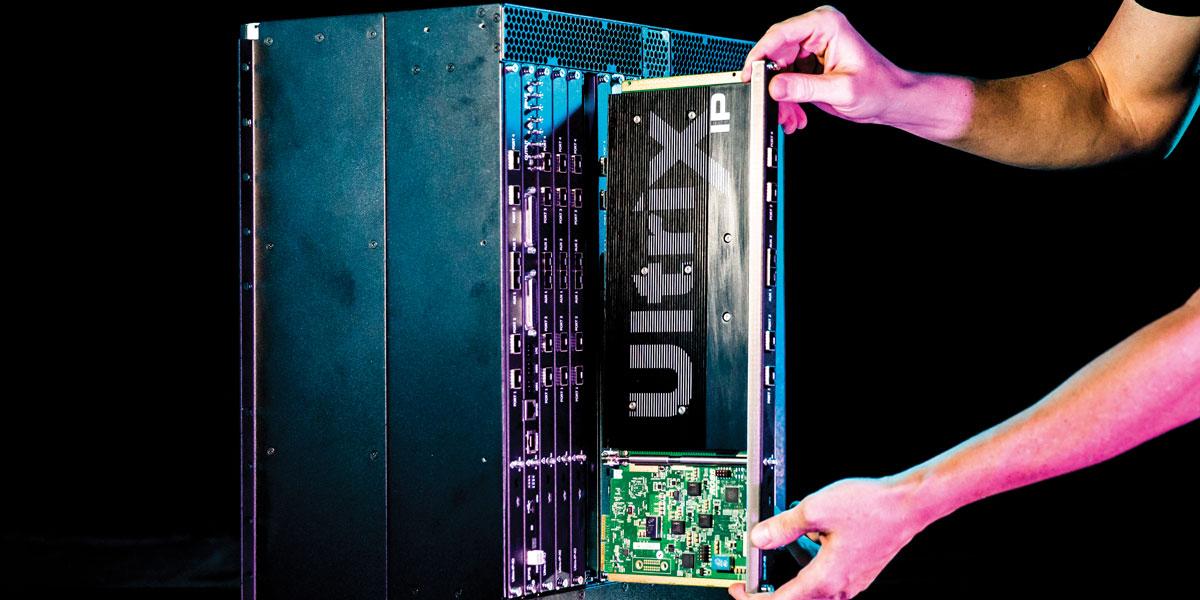Less is More
Harder, better, faster, stronger – Ross Video’s Hyperconverged Solutions improve production efficiency

Sponsored editorial
Hyperconverged Solutions might sound complicated, but the concept is simple; we use hyperconverged products, like smartphones, in our everyday lives.” According to Alun Fryer, Ross Video’s technical marketing lead on Hyperconverged Solutions, “it’s taking what used to be a bunch of separate pieces of equipment or parts of a solution and combining all of them into one.
“If we go back 20 years, we might have walked around with a phone and a camera and a calendar,” explains Fryer. “Now, it’s all in our phone.” For broadcasters, the phone, camera and timer in question are replaced by routers, production switchers, audio mixers and other pieces of physical equipment. When these separate solutions are condensed into a single platform, creators save time, money, space, and – importantly – energy.
Green gadget
Ross Video’s Hyperconverged Solutions, like the Ultrix, are environmentally friendly on several fronts. Firstly, “there’s less material being used. That of course means at the end of the life cycle, there’s less waste, less material we have to reclaim, there’s less going into a landfill,” says Fryer.
Not only are Hyperconverged Solutions smaller, but they’re denser. “Denser circuitry, fewer cords, fewer power supplies… there’s less power being used to make the solution work,” states Fryer. “Less energy is ultimately less CO2 emission.”
There are other, less obvious ways Hyperconverged Solutions foster sustainable practices – one being their modularity. The rate of change in the production industry is exponential, with customers demanding new capabilities every few years.
“There’s a great quote that I love to use,” begins Fryer. “‘Broadcast equipment doesn’t fail, it expires.’ Typically, a lot of our customers find they’ve got this piece of equipment that can last ten or 15 years, but after five, it’s no longer relevant,” he continues. “Standards move, workloads change, they need to do things that it can’t.
“What we’ve attempted to do with our Hyperconverged platform is constantly add upgrades to meet new market challenges and new customer requirements,” explains Fryer. Because the solution is modular, individual parts can be replaced or updated without warranting an entirely new system. This keeps the product relevant for a longer period, resulting in even less waste.
This or that
As with most things, Hyperconverged Solutions involve making some trade-offs. As Fryer explains: “There’s a desire to adapt to new things, and one way the industry has answered that is by moving to more software- and cloud-based processing. Those can be among the least efficient in terms of energy consumption per operation compared to more traditional, hardware-based approaches.”
Thanks to the cloud, rates of production are exploding, with remote operation made possible. That said, it isn’t all good news: “There was a study done in 2021, and it showed that OTT delivery used 48% more energy than OTA. I mean, that’s going in the wrong direction from an environmental standpoint,” argues Fryer. “Coupled with that, we’re creating more content than ever – and we’re delivering it less efficiently. We’ve got to do something to ratchet that back.”
Hyperconverged Solutions are attempting to address the issue by combining a hardware-based platform with software-based programming, combining the sustainability of the former with the flexibility of the latter.
Doing the research
While environmental impact can be difficult to quantify, Fryer’s taken on the task, developing a ‘what if’ case study with Ross Video’s mobile production arm, Ross Production Services. By analysing the design of an OB van, Fryer was able to estimate its energy consumption – both at present and with a hypothetical Hyperconverged Solution.
“Roughly, we cut consumption by about a third,” recounts Fryer. “We saved, I think, about a third on the equipment weight alone – one of the more significant savings was on the cables themselves.” His official findings will be published in the SMPTE journal later this year.
No time like now
As an industry – and as a society at large – ‘hyperconverged’ seems to be the direction we’re heading in. Ross Video began this journey over a decade ago when it married switchers and routers in a single platform, and builds on that principle today with the Ultrix platform. “Let’s see what’s going to give us the best longevity and environmental impact,” says Fryer.
As the broadcast and production industries put more pressure on organisations to commit to green practices, sustainability isn’t just a buzzword – it’s a necessity. “Our clients are very concerned about dealing with suppliers that are taking sustainability seriously,” says Fryer.
For those seeking a genuine solution, “Hyperconverged is a great platform for saving space, complexity and energy,” describes Fryer. “It can really help hit those goals.”
More information: rossvideo.com/use-cases/hyperconverged
Originally published in the Winter 2023 issue of FEED
